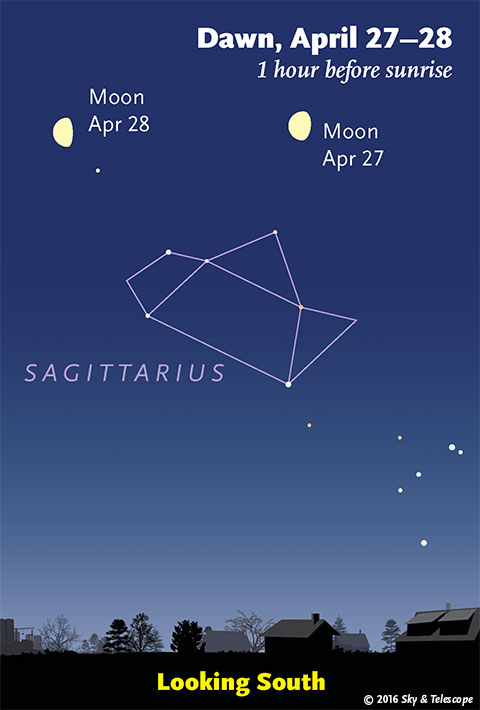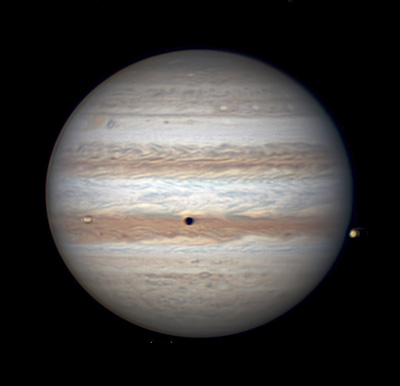This Week’s Sky at a Glance, April 22 – 30
• As night descends, look high in the west for Pollux and Castor lined up almost horizontally (depending on your latitude). Pollux and Castor, the heads of the almost-upright Gemini twins, form the top of the enormous Arch of Spring. The two ends of the Arch are Procyon to their lower left, and brighter Capella farther to their lower right. Also part of the Arch is fainter Menkalinan (Beta Aurigae), upper left of Capella. The whole thing sinks in the west through the evening.

On Monday morning the 25th, the waning gibbous Moon will form a quadrilateral with Mars, Saturn and Antares from the early-morning hours into the dawn.

Get up before dawn this week to say an early hello to the Sagittarius Teapot, an icon of late summer.
Saturday, April 23
• Arcturus is the brightest star in the east these evenings. Spica shines about three fists at arm's length to its lower right. To the right of Spica by half that distance is the distinctive four-star constellation Corvus, the Crow of Spring.
Sunday, April 24
• The waning gibbous Moon rises late this evening and is well up by midnight. By then you can see that it forms an irregular quadrilateral, about 10° across, with bright Mars, Saturn, and fainter Antares. They're in the south-southwest by the time dawn brightens on Monday morning the 25th, as shown at right.
Monday, April 25
• The waning gibbous Moon shines nearly in a straight line with Saturn and Mars on Tuesday morning the 26th (depending on your location), as shown above. Their best time for telescopic observation is when they're highest: around 3 a.m.
Tuesday, April 26
• Bright Jupiter stands high due south at nightfall. To its right is the Sickle of Leo, upright with Regulus marking the bottom of its handle. The Sickle's second-brightest star is Algieba, Gamma Leonis, a fine double star for telescopes. With the Moon now gone from the evening sky, explore the faint galaxy groups around Algieba with Sue French's Deep-Sky Wonders article, charts, and photos in the April issue of Sky & Telescope, page 54.
Wednesday, April 27
• Face north just after nightfall, look very high, and you'll find the Pointers — the end stars of the Big Dipper's bowl — on the meridian, pointing toward Polaris straight down below. From the Pointers to Polaris is about three fists at arm's length.
Thursday, April 28
• At nightfall, Jupiter high in the south and Arcturus high in the east-southeast are the two brightest points on their side of the sky. The brightest star below them is Spica.
Friday, April 29
• Last-quarter Moon (exact at 11:29 p.m. EDT). The Moon rises tonight around 2 a.m. tonight local daylight-saving time. It shines above dim Capricornus before the first light of dawn.
• It's a busy night at Jupiter. Io crosses the planet's face from 9:42 to 11:57 p.m. EDT, followed by its tiny black shadow from 10:44 p.m. to 12:58 a.m. EDT. Europa transits the planet from 12:28 to 3:25 a.m. EDT, followed by its shadow from 2:47 to 5:32 a.m. EDT.
Meanwhile, Jupiter's Great Red Spot crosses the planet's meridian around 10:52 p.m. EDT. (Subtract three hours from all times to get PDT.)
Saturday, April 30
• These evenings, the long, dim sea serpent Hydra snakes far across the southern sky. Find his head, an asterism about the width of your thumb at arm's length, in the southwest. It's to the lower right of Regulus by about two fists at arm's length. Hydra's tail reaches all the way to Libra rising in the southeast. His star pattern, from forehead to tail-tip, is 95° long.
_________________________
Want to become a better astronomer? Learn your way around the constellations. They're the key to locating everything fainter and deeper to hunt with binoculars or a telescope.
This is an outdoor nature hobby. For an easy-to-use constellation guide covering the whole evening sky, use the big monthly map in the center of each issue of Sky & Telescope, the essential guide to astronomy.

The Pocket Sky Atlas plots 30,796 stars to magnitude 7.6 — which may sound like a lot, but it's less than one per square degree on the sky. Also plotted are many hundreds of telescopic galaxies, star clusters, and nebulae. Shown above is the new Jumbo Edition for easier reading in the night. Click image for larger view.
Once you get a telescope, to put it to good use you'll need a detailed, large-scale sky atlas (set of charts). The basic standard is the Pocket Sky Atlas (in either the original or new Jumbo Edition), which shows stars to magnitude 7.6.
Next up is the larger and deeper Sky Atlas 2000.0, plotting stars to magnitude 8.5, nearly three times as many. The next up, once you know your way around, is the even larger Uranometria 2000.0 (stars to magnitude 9.75). And read how to use sky charts with a telescope.
You'll also want a good deep-sky guidebook, such as Sue French's Deep-Sky Wonders collection (which includes its own charts), Sky Atlas 2000.0 Companion by Strong and Sinnott, or the bigger Night Sky Observer's Guide by Kepple and Sanner.
Can a computerized telescope replace charts? Not for beginners, I don't think, and not on mounts and tripods that are less than top-quality mechanically (meaning heavy and expensive). And as Terence Dickinson and Alan Dyer say in their Backyard Astronomer's Guide, "A full appreciation of the universe cannot come without developing the skills to find things in the sky and understanding how the sky works. This knowledge comes only by spending time under the stars with star maps in hand."
This Week's Planet Roundup

Mars was 14.4 arcseconds wide on April 19th when Phil Miles of Queensland, Australia, took this image with a 20-inch reflector. South is up. Dark Sinus Sabaeus and Sinus Meridiani extend in from the left (preceding). The pointy peninsula a bit farther right is the Oxia Palus region. Lower right from there are big Niliacus Lacus and Mare Acidalium. The North Polar Cap has almost shrunken away in the northern-hemisphere summer. Clouds appear in the wintry far south and especially around the morning limb.

Jupiter on April 19th, imaged at 12:56 UT by Christopher Go in the Philippines with a 14-inch Schmidt-Cass scope. South here is up. Europa, at right, is five minutes from crossing onto Jupiter's following (celestial eastern) limb. Io is most of the way across Jupiter's face, with its shadow following behind (because Jupiter is past opposition). Far south of Io is reddish Oval BA with a small gray spot following just behind it.

Jupiter's other side, imaged by S&T's Sean Walker on April 21st with a 12.5-inch scope. The Great Red Spot remains vivid. Dark clouds line the Red Spot Hollow.

Saturn's rings are wide open this season, tipped 26° to our line of sight and extending above the planet's north and south poles. Damian Peach took this image with a 14-inch Schmidt-Cass on March 19th. South is up.
Mercury fades away in the sunset this week, low in the west-northwest. It's still magnitude +0.9 on Friday the 22nd but dims away to +2.7 by Friday the 29nd, while also sinking lower. Don't confuse Mercury with Aldebaran twinkling 18° to its upper left.
Venus is lost in the glare of the Sun.
Mars (about magnitude –1.3, in the legs of Ophiuchus above Scorpius), rises around 10 or 11 p.m. daylight-saving time. It blazes highest in the south around 2 or 3 a.m., to the right of dimmer Saturn and above Antares. In a telescope Mars grows this week from a healthy 15 to 16 arcseconds in diameter. See our telescopic Mars guide in the April issue of Sky & Telescope, page 48.
At its closest approach to Earth in late May, Mars will reach an apparent diameter of 18.6 arcseconds, its largest since 2005. At its next opposition and closest approach, in July 2018, it will grow to 24.3 arcseconds — nearly the largest we can ever see it.
Jupiter (magnitude –2.3, in southern Leo) dominates the southern sky these evenings. Nothing else is nearly so bright. See our telescopic guide to Jupiter in the March issue of Sky & Telescope, page 48.
Saturn (magnitude +0.3, also in the legs of Ophiuchus above Scorpius) rises about a half hour after brighter, more colorful Mars does, following 7° or 8° to its lower left. By early dawn they stand in the south-southwest, with Saturn now upper left of Mars. Fainter Antares, 5° to Mars's lower left, makes it a triangle.
Uranus is hidden in the sunrise.
Neptune is very low in the east-southeast as dawn begins.
No comments:
Post a Comment